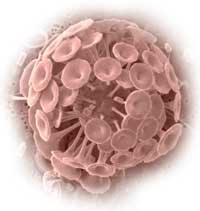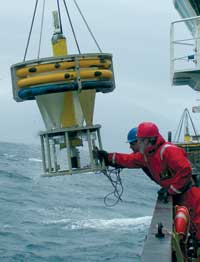Bringing global climate change to the classroom Teach article
Ivo Grigorov from the EurOCEANS project describes how the deep seas can help us to understand and predict climate change.

It’s spring. It’s dark, but then it always is. The drift is gentle, it’s the calm before the storm. You would have to be on the Nautilus sitting next to Captain Nemo to experience it. At first sight not much lives here, and what life there is, is more suitable for a 1960s horror sci-fi film than for factual science. The pressure is enormous and seawater corrosion is vicious. Even treated steel is reduced to crumbs after a year, yet delicate life forms thrive here. Gelatinous sea stars of all varieties and deep-sea cucumbers are all waiting for the ‘snow’. Pretty soon they are rewarded. The ‘blizzard’ starts and covers the sea bed. Sometimes it is so intense that visibility is reduced to zero. This is deep-sea whiteout. You can’t see much but it’s an awesome sight.
The depths of the oceans hide many secrets which at first glance have little to do with our daily lives. If deep-sea ‘blizzards’ tickle your imagination, and Captain Nemo’s Nautilus is not at hand, no problem! Just climb aboard the online weblog of the UK’s oceanographic research ship Discovery.
Every year oceanographers from the National Oceanography Centre in Southampton, UK, organise an oceanographic cruise to the North Atlantic and invite students and teachers to join them at the frontier of multidisciplinary research in almost real time. Day by day, students and teachers can follow life and research at sea, send questions to the scientists and learn about climate change and how it is measured and studied.

Images courtesy of Richard Lampitt, NOCS

Discovery deploying a
sediment trap west of the
English Channel to capture
sinking marine snow and
analyse its composition
Image courtesy of Richard
Lampitt, NOCS
The aim of the cruise is to continuously measure the fall of these deep-sea ‘blizzards’ to the depths of the ocean and find out how they are linked to the climate we experience every day.
So what are deep-sea ‘blizzards’? The ‘snowflakes’ are not of the familiar type. Most of them are the settling remains of a battle taking place at the surface of the oceans. Except for a very thin sun-lit layer, the ocean is a dark and cold place. At its surface, however, the Sun supports a diverse variety of single-celled phytoplankton. These are the green meadows of the oceans on which the majority of the ecosystem relies for food.
The single-celled phytoplankton are grazed by agile zooplankton armed with fierce mandibles ready to crush anything in their path. But for the zooplankton, it is not a simple triumph. Although single-celled phytoplankton cannot outswim the fast zooplankton, their strength is in numbers. Despite their microscopic size, the phytoplankton can bloom in such high densities that long wisps gently swayed by the ocean currents can be seen even from space.
Phytoplankton armour also includes spines, hooks and all-encompassing calcite, glass or organic shells. These are the architects-supreme of the nano-world. Their shell designs not only serve a protective purpose, but are also intricate and elegant, providing maximum functionality with minimum material – every architect’s dream.
But even when the body armour serves its purpose, the phytoplankton blooms have a limited lifespan. Nutrients in the surface waters are eventually exhausted and the blooms settle out of sight, into the depths. Moults of marine crustaceans, faecal pellets of animals of all sizes, and dust swept off the continents by the wind also accompany the dead plankton to the bowels of the ocean. Together, these remnants are termed ‘marine snow’. And at depths of 4500 m, the ‘snowflakes’ seem to go in all directions, depending on the prevailing currents – rather like snow blizzards, kilometres above.

Images courtesy of sinia planeta
Trapping and analysing the fragile ‘snowflakes’ requires the services of engineers and materials scientists who design instruments that will survive very hostile conditions for months and years at a time. Once the marine snow has been gathered, identifying its composition takes many chemists and biologists. Even computer scientists and mathematicians help, creating sophisticated computer models and trying to simulate the processes that form the deep sea ‘blizzards’.
This phenomenon, however, is more than just a ‘strange but true’ fact. This is deep-sea climate, and it is directly linked to climate changes around the world, both past and future. After the burst of spring productivity at the ocean’s surface, the sea bed is covered with the nutritious snow of organic material. Some of it feeds deep-sea animals, but some of it is buried in subsequent years, forming layer upon layer of deep-sea sediments. Just as tree rings can tell us about annual rainfall and forest fires, and the trapped bubbles in the layers of ice in ancient glaciers help us to recreate the composition of the atmosphere, deep-sea sediments contain a wealth of information on how the oceans function and interact with the rest of the planet. The watery two-thirds of our planet act as a radiator, with the top few metres of its surface containing more heat than the entire atmosphere. A well-known example today is the Gulf Stream, which brings warm tropical waters to European shores. But how did it behave in the past? How much heat did ocean currents carry, and where did they take it? And as for the future, how will these same currents behave under the pressure of human activity?
The answer lies in the chemical composition of deep-sea ‘blizzards’. Understanding their biology and chemistry is the key to unlocking the secrets of the deep-sea layers they form. The shells of the long dead and buried phytoplankton within these layers hold clues to the climate conditions under which they were formed. Their isotopic composition can tell us about sea surface temperature, nutrients and productivity in the oceans, and the amount of wind-borne dust gives clues to the planet’s aridity and wind regimes millions of years ago. And knowing the past is key to predicting climate change in the future.
Today, scientists can recreate sea surface temperature, ocean currents and wind patterns, as well as how much polar ice caps changed and how this caused sea level to oscillate by more that 100 m. Reading the sedimentary encyclopaedia formed by annual deep sea ‘blizzards’ is not just an exercise in curiosity. All these parameters shape the weather we experience every day.
The climate puzzle is a complex one. It transcends the boundaries of the scientific disciplines that we are so used to at school, and requires co-operation between geologists and chemists, biologists and mathematicians. It also fosters a new breed of scientist – the type that seeks answers in areas where they have little knowledge. It creates a new science too – the multidisciplinary type, where the boundaries between biology, chemistry and mathematics melt away.
Learn more
To find out more about how oceanographers measure the deep-sea ‘blizzards’ and what it takes to be an oceanographer, visit the online weblog of Discovery Oceanography Expedition 2006. The annual weblog is a joint project between sinia planeta (Bulgaria) together with National Oceanography Centre, Southampton (UK) and EurOCEANS – the European Network of Excellence for OCean Ecosystem ANalysiS. The 2006 weblog was run in English, French, Portuguese, Bulgarian and Turkish.
How to get involved
In the third Discovery Cruise online diary, now running, scientists are chasing Saharan dust over the Atlantic Ocean. They we also will release an ocean current float which students can track via a satellite link and the web interface.
Students can still put their questions to the scientists involved in the 2006 oceanographic cruise by contacting Ivo Grigorov. Please include the name and location of your school.
Teachers keen to involve their science class, in real time during future oceanography expeditions or in future web conferences with European oceanographers and climate change scientists, can express their interest to Ivo Grigorov or Sylvain Ghiron.
Other projects and materials from the partners
EurOCEANS
The European Network of Excellence for OCean Ecosystem ANalysiS focuses on the future impact of climate change on the ocean ecosystem. The research of its members is disseminated through:
- Short films – regularly released short films on topical issues such as climate change and ocean acidification (Languages: English, French)
- Web conferences – live online conferences and Q&A sessions with European oceanographers and climate change researchers. To express your interest, contact Sylvain Ghiron for announcement of the next conference. (Languages: English, French)
- Educational cards – currently in French but other European languages can be supplied depending on demand: www.eur-oceans.info
To date, schools from France, UK and Italy have taken part in the EurOCEANS educational projects. To express and register your interest, contact edu-contact@eur-oceans.info or visit www.eur-oceans.info/education/.
National Oceanography Centre (NOC), Southampton, UK
NOC is a leading research institution and produces the Oceans4Schools online educational aids as well as a very popular series of posters on earth science topics. The institute also has a project that lets teachers participate in oceanographic cruises. Visit www.noc.soton.ac.uk (Language: English)
Review
Ivo Grigorov draws a colourful picture of the ocean world and introduces a non-traditional, highly interesting way of predicting global climate change, based on studying deep-sea ‘blizzards’. In doing so, he draws attention to two important issues in modern science research: how various science disciplines are often brought together to study a single phenomenon, and how research can be made available to those interested, including high-school students.
This is crucial in developing students’ attitudes towards science as it makes it more attractive to them. Furthermore, as this method of studying global climate change deals with a mostly unknown world, the mysteriousness of which fascinates people, it is likely to capture students’ imagination and motivate them to learn more.
In the classroom, projects can be designed to investigate how the findings from the study of the deep-sea ‘blizzards’, made readily available by the actual research scientists, can correlate with the surface climate and other global phenomena. Such studies might require co-operation between students studying a variety of science disciplines, including biology, chemistry, geography and geology. This can emphasise the interdisciplinary nature of modern science.
Michalis Hadjimarcou, Cyprus





